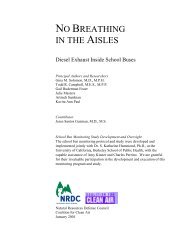US Nuclear Weapons in Europe - Natural Resources Defense Council
US Nuclear Weapons in Europe - Natural Resources Defense Council
US Nuclear Weapons in Europe - Natural Resources Defense Council
Create successful ePaper yourself
Turn your PDF publications into a flip-book with our unique Google optimized e-Paper software.
U.S. <strong>Nuclear</strong> <strong>Weapons</strong> <strong>in</strong> <strong>Europe</strong> • Hans M. Kristensen/<strong>Natural</strong> <strong>Resources</strong> <strong>Defense</strong> <strong>Council</strong>, 2005<br />
CONCL<strong>US</strong>IONS AND RECOMMENDATIONS<br />
The reductions <strong>in</strong> the number of nuclear weapons <strong>in</strong> <strong>Europe</strong> <strong>in</strong> the early 1990s were a<br />
bold and necessary step. They enhanced <strong>Europe</strong>an security and helped facilitate the<br />
end<strong>in</strong>g of the Cold War and the transformation of NATO. What has been lack<strong>in</strong>g s<strong>in</strong>ce<br />
then is a vision for how to follow up and f<strong>in</strong>ish the process of withdraw<strong>in</strong>g U.S. forwarddeployed<br />
nuclear weapons from <strong>Europe</strong>.<br />
At every juncture and follow<strong>in</strong>g every reductions and modification of the posture, NATO<br />
bureaucrats have reaffirmed the importance of ma<strong>in</strong>ta<strong>in</strong><strong>in</strong>g U.S. nuclear weapons<br />
forward-deployed <strong>in</strong> <strong>Europe</strong>. The justifications are poorly expla<strong>in</strong>ed and muddled,<br />
consist<strong>in</strong>g of remnants of Cold War rationales about a Russian threat, vague missions<br />
such as war prevention, ambiguous suggestions like deterr<strong>in</strong>g proliferation of weapons<br />
mass destruction, and dubious claims about nuclear weapons provid<strong>in</strong>g a unique l<strong>in</strong>k<br />
between <strong>Europe</strong> and its North American allies.<br />
What characterizes these justifications is an <strong>in</strong>fatuation with Cold War rationales and a<br />
fear of tak<strong>in</strong>g the next bold step to f<strong>in</strong>ally br<strong>in</strong>g <strong>Europe</strong> out of the Cold War:<br />
At a time when NATO and the United States seek a new partnership with Russia and are<br />
concerned over the security of Russian tactical nuclear weapons, the <strong>in</strong>terests of the<br />
alliance are not served by keep<strong>in</strong>g hundreds of nuclear weapons forward-deployed <strong>in</strong><br />
<strong>Europe</strong>. The presence of these weapons is a cont<strong>in</strong>uous irritant to normalizations and an<br />
unnecessary and counterproductive factor <strong>in</strong> Russian military plann<strong>in</strong>g.<br />
At a time when <strong>Europe</strong> and the United States need to build a foundation for political and<br />
military cooperation to address the challenges fac<strong>in</strong>g both countries and their regions, the<br />
<strong>in</strong>terests of NATO are not served by suggestions that remnants of a Cold War nuclear<br />
posture is the “glue” that ensures close ties across the Atlantic. <strong>Europe</strong>an NATO allies<br />
have plenty of burden to share on non-nuclear missions, such as force structure<br />
modernizations, peacekeep<strong>in</strong>g operations, and rapid reaction forces. Those are the issues<br />
that NATO should focus on to provide the “glue” across the Atlantic s<strong>in</strong>ce they will<br />
determ<strong>in</strong>e the future of the alliance, rather than cl<strong>in</strong>g<strong>in</strong>g to outdated arrangements from a<br />
time and situation that has now passed. Besides, if the 480 nuclear weapons were<br />
removed tomorrow, NATO’s security <strong>in</strong>terests would still be supported by thousands of<br />
other United States, British, and French nuclear weapons that cont<strong>in</strong>ue to be modernized<br />
for essentially the same reasons.<br />
At a time when both <strong>Europe</strong> and the United States are engaged <strong>in</strong> high-profile diplomatic<br />
nonproliferation efforts around the world to promote and enforce non-proliferation of<br />
nuclear weapons, deploy<strong>in</strong>g hundreds of such weapons <strong>in</strong> non-nuclear NATO countries<br />
and tra<strong>in</strong><strong>in</strong>g the air forces of non-nuclear NATO countries – <strong>in</strong> peacetime – to deliver<br />
these weapons <strong>in</strong> times of war is at cross purposes with an effective non-proliferation<br />
message. All of the non-nuclear NATO countries that host nuclear weapons on their<br />
70
















